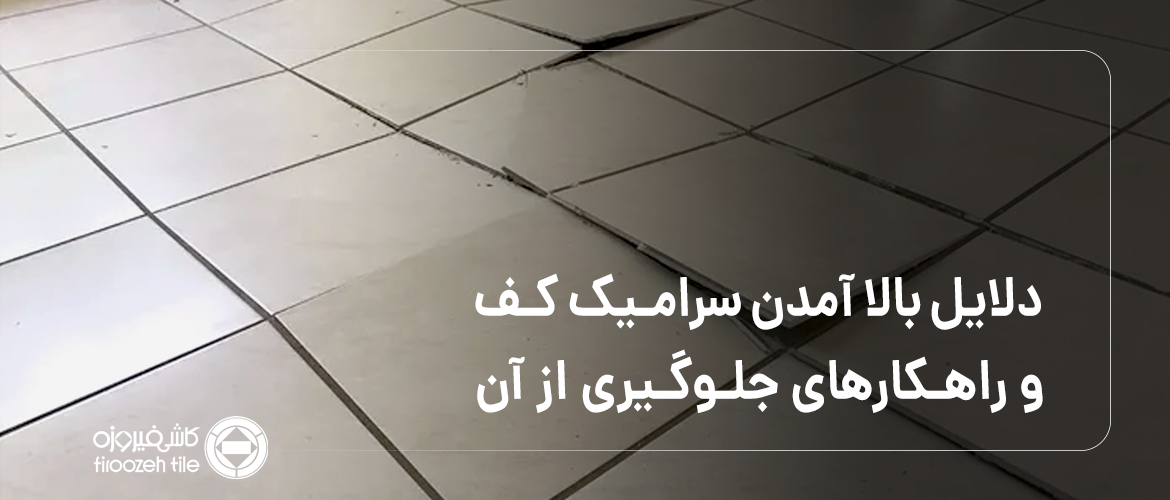
Causes of Floor Tile Lifting and How to Prevent It
Ceramic floor tiles are one of the most popular building coatings used for their beauty, durability, and high resistance to wear. But sometimes, after a while, we see ceramics lifting or loosening, which can cause many problems. In this article, we will examine the reasons for ceramic floor tiles lifting and the solutions for preventing and repairing them.
The main reasons for ceramic floor tiles lifting
1. Installation problems
Improper installation is one of the most common reasons for ceramic tiles lifting. Some of the mistakes in the installation process are:
• Using inappropriate mortar: Using dry or stiff mortar reduces the adhesion of ceramics to the underlying surface.
• The underlying surface is not smooth: If the building floor is uneven, ceramics will not be installed evenly and will loosen over time.
• Failure to observe the appropriate distance between ceramics: Ceramics need space to contract or expand due to expansion and contraction. Failure to comply with the standard distance (3 to 5 mm) will cause them to compress and rise.
2. The effect of temperature changes
Ceramics expand and contract when exposed to temperature changes. This is more common in areas with high temperature differences between night and day or in open spaces without a roof, such as yards and terraces. If the ceramics are not properly sealed, temperature changes will cause them to rise.
3. Quality of materials and mortar
• Use of substandard materials: Using substandard mortar will cause the ceramics to separate
• Improper adhesive: In some cases, the use of poor-quality ceramic adhesives will cause the ceramics to separate.
4. Building settlement
• Building settlement: Over time, the floor of the building may settle and cause the ceramics to move. This issue is more common in newly built buildings.
5. Other effective factors
• Large size of ceramics: Larger ceramics require more mortar to adhere. If the mortar is distributed improperly, the possibility of their separation and lifting increases.
• High traffic and pressure: In places with high traffic, the possibility of ceramics loosening and lifting increases. For such places, it is better to use special adhesives and mortar with standard thickness.
• Failure to perform improper jointing: Improper jointing or failure to use sealant causes water to penetrate and, as a result, the ceramics to separate.
Methods for preventing ceramic lifting
1. Using high-quality mortar and adhesive: High-quality cement mortar and standard adhesives increase the adhesion and durability of ceramics.
2. Maintaining the standard distance between ceramics: Creating an appropriate distance (3 to 5 mm) using mastic or special crosses reduces the pressure on ceramics.
3. Proper jointing: To prevent water and moisture penetration, it is essential to use proper jointing.
4. Reducing the effect of environmental conditions: In open environments, the use of thermal insulation or awnings can reduce the effect of temperature changes.
5. Leveling the subsurface: Before installation, the floor of the building must be leveled and leveled so that the ceramics can be glued evenly.
6. Using specialized labor: Ceramic installation must be carried out by skilled craftsmen to meet all necessary standards.
Repair and troubleshooting solutions
If your building's floor ceramics have a problem, the following methods are recommended to fix it:
1. Investigate and identify the cause: First, determine the main cause of the ceramic rising. This will help you prevent similar problems in the future.
2. Removing damaged ceramics: Using appropriate tools, carefully remove the raised ceramics.
3. Cleaning the Substrate: Remove any dust or remaining adhesive from the substrate so that the new adhesive can adhere well.
4. Using the right mortar or adhesive: Cover the substrate with a quality adhesive or mortar and place the new ceramic in place.
5. Pressing and leveling: After installation, gently secure the ceramic in place using a rubber hammer or special tools.
6. Re-caulking: After the mortar dries, re-caulk to prevent water infiltration.
7. Using sealants: To prevent future problems, special mastics can be used to fill the joints.
Conclusion and final recommendations
Lifting floor ceramic tiles is a common problem in buildings, which can be caused by improper installation, temperature changes, poor quality materials, or building settlement. This problem can be prevented by following technical principles during installation, using quality materials, and performing standard jointing. In the event of a problem, damaged ceramics should be properly repaired or replaced to prevent further damage. Also, to ensure proper installation, it is recommended to use professional labor to reduce future maintenance and repair costs. By following the tips mentioned in this article, the durability and beauty of building floor ceramics can be maintained.
